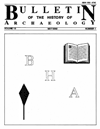David George Hogarth at Asyut, Egypt, 1906-1907. The History of a "lost" Excavation
DOI:
https://doi.org/10.5334/bha.05202Keywords:
Rope, British Museum, Cordage,Abstract
While engaged in a study of ancient Egyptian cordage in the British Museum during 1984, I came across a fragment of rope recovered from Asyut, Egypt, by the British archaeologist, D.G. Hogarth. In investigating this artifact, I learned that this excavation by Hogarth was known to very few scholars and had never been published. Intrigued by the data I encountered in Hogarth's notes, I initiated a project to organize, clarify, and make available the information found therein. A reconstructed excavation report based on Hogarth's field notes, correspondence and British Museum records is currently in press (Ryan, in press).Apart from the archaeological data itself which is of significant Egyptological interest, Hogarth's material provides an intriguing personal glimpse at the goings-on of an Egyptian excavation in the early part of the 20th century. Various documents provide much of the story from the conception of the idea for an expedition to the ultimate disposition of many of the artifacts derived therefrom.
Downloads
Published
Issue
Section
License
Copyright (c) 1995 The Author(s)

This work is licensed under a Creative Commons Attribution 4.0 International License.
Authors who publish with this journal agree to the following terms. If a submission is rejected or withdrawn prior to publication, all rights return to the author(s):
- Authors retain copyright and grant the journal right of first publication with the work simultaneously licensed under a Creative Commons Attribution License that allows others to share the work with an acknowledgement of the work's authorship and initial publication in this journal.
- Authors are able to enter into separate, additional contractual arrangements for the non-exclusive distribution of the journal's published version of the work (e.g., post it to an institutional repository or publish it in a book), with an acknowledgement of its initial publication in this journal.
- Authors are permitted and encouraged to post their work online (e.g., in institutional repositories or on their website) prior to and during the submission process, as it can lead to productive exchanges, as well as earlier and greater citation of published work (See The Effect of Open Access).
Submitting to the journal implicitly confirms that all named authors and rights holders have agreed to the above terms of publication. It is the submitting author's responsibility to ensure all authors and relevant institutional bodies have given their agreement at the point of submission.
Note: some institutions require authors to seek written approval in relation to the terms of publication. Should this be required, authors can request a separate licence agreement document from the editorial team (e.g. authors who are Crown employees).

